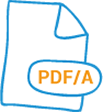The PDF/A-2 standard was published in 2011. Opposite to PDF/A-1, PDF/A-2 is entirely based on guidelines of ISO (International Organization for Standardization) as published in ISO standard “ISO-32000”.
If PDF/A-1 meets your requirements for archiving you don't need to change to PDF/A-2.
Improvements of PDF/A-2 compared to PDF/A-1
- Store images in lossless compression thanks to the JPEG2000 file format

As result PDF documents with images are smaller and therefore much easier to upload or download. - Thanks to Unicode it's guaranteed you can search your text
Unicode allows you to index your text. Also you can reliably convert text from a PDF document to e.g. another word processor. - Multiple PDF layers
Multiple layers allow the author to show one and the same page in a different language with just a push of a button. Applications for AutoCAD drawings are possible. - Support of multiple fonts
Because PDF/A-2 supports multiple fonts it's easy and safe to convert files to PDF/A-2. So you don't need to convert your documents to a supported font first. - Transparency
Due to the built-in transparency marked text can be easily read. Also shadows are now possible. - Pagesizes are supported up to 381km×381km
In some cases PDF/A format is used for archiving maps or blueprints. With PDF/A-1 this was limited to sizes of 5.08m × 5.08m. Due to down scaling of images much detail was lost. With PDF/A-2 images can be stored with sizes up to 381km × 381km. - Improved metadata functionality
- Conversion of old standards like PDF/X-4 and PDF/E-1 to PDF/A-2
- Compatibility to other ISO standards as PDF/X-4 and PDF-E-1


 English (UK)
English (UK)  Nederlands
Nederlands